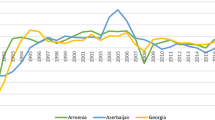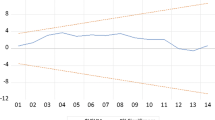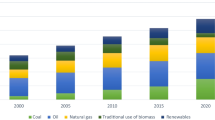Abstract
This paper aims to examine the long-term causal relationship between renewable energy, CO2 emissions, and economic growth in the four Mediterranean countries; including France, Spain, Italy, and Turkey over the 1980–2012 period. The results of Pedroni and Kao co-integration tests indicate a long-term relationship between these variables. In fact, the results of the long-term model show that the growth has a significant and positive impact on CO2 emissions in the four countries. VECM Granger causality analysis offer conflicting evidence on the links between renewable energy use and economic growth which supported the feedback hypothesis. This finding has vital consequences regarding energy and economic policy, as it suggests that renewable energy use do not seem to damage economic growth and development in these countries.
Similar content being viewed by others
References
Abid, M. (2014). Energy consumption-informal economic growth analysis: what policy options do we have? Journal of the Knowledge Economy, 6, 1–12.
Abid, M., & Mraihi, R. (2014). Disaggregate energy consumption versus economic growth in Tunisia: cointegration and structural break analysis. Journal of the Knowledge Economy, 6, 1–19.
Andersson, F. N. G., & Karpestam, P. (2013). CO2 emissions and economic activity: short and long run economic determinants of scale, energy intensity and carbon intensity. Energy Policy, 61, 1285–1294.
Apergis, N., & Payne, J. E. (2009). Energy consumption and economic growth: evidence from the Commonwealth of Independent States. Energy Economics, 31(5), 641–647.
Apergis, N., & Payne, J. E. (2010a). Renewable energy consumption and growth in Eurasia. Energy Economics, 32(6), 1392–1397.
Apergis, N., & Payne, J. E. (2010b). Renewable energy consumption and economic growth: evidence from a panel of OECD countries. Energy Policy, 38(1), 656–660.
Apergis, N., & Payne, J. E. (2011). The renewable energy consumption-growth nexus in Central America. Applied Energy, 88(1), 343–347.
Apergis, N., & Payne, J. E. (2014). Renewable energy, output, CO 2 emissions, and fossil fuel prices in Central America: evidence from a nonlinear panel smooth transition vector error correction model. Energy Economics, 42, 226–232.
Beckerman, W. (1992). Economic growth and the environment: whose growth? Whose environment? World Development, 20(4), 481–496.
Burnett, J. W., Bergstrom, J. C., & Wetzstein, M. E. (2013). Carbon dioxide emissions and economic growth in the US. Journal of Policy Modeling, 35(6), 1014–1028.
Engle, R. F., & Granger, C. W. (1987). Co-integration and error correction: representation, estimation, and testing. Econometrica: Journal of the Econometric Society, 251–276.
Friedl, B., & Getzner, M. (2003). Determinants of CO2 emissions in a small open economy. Ecological Economics, 45(1), 133–148.
Georgescu-Roegen, N. (1971). The entropy law and the economic process. Cambridge: Harvard University Press.
Grossman, G. M., & Krueger, A. B. (1995). Economic growth and the environment. Quarterly Journal of Economics, 110(2), 353–377.
Harris, R., & Sollis, R. (2003). Applied time series modelling and forecasting. Wiley.
Hilaire, N., & Fotio, H. K. (2015). Effects of economic growth on CO2 Emissions in the Congo Basin countries. International Journal of Economics and Finance, 7(1), 107.
Holtz-Eakin, D., & Selden, T. M. (1995). Stoking the fires? CO2 emissions and economic growth. Journal of public economics, 57(1), 85–101.
Jbir, R., & Zouari-Ghorbel, S. (2009). Recent oil price shock and Tunisian economy. Energy Policy, 37(3), 1041–1051.
Jia, R., Guo, X., & Marinova, D. (2013). The role of the clean development mechanism in achieving China’s goal of a resource-efficient and environmentally friendly society. Environment, Development and Sustainability, 15(1), 133–148.
Kao, C. (1999). Spurious regression and residual-based tests for cointegration in panel data. Journal of econometrics, 90(1), 1–44.
Kulionis, V. (2013). The relationship between renewable energy consumption, CO2 emissions and economic growth in Denmark.
Lee, C. C., & Chang, C. P. (2008). Energy consumption and economic growth in Asian economies: a more comprehensive analysis using panel data. Resource and Energy Economics, 30(1), 50–65.
Leitão, N. C. (2014). Economic growth, carbon dioxide emissions, renewable energy and globalization. International Journal of Energy Economics and Policy, 4(3), 391–399.
Lo, A. Y., & Chow, A. T. (2015). The relationship between climate change concern and national wealth. Climatic Change, 1–14.
Mbarek, M. B., Ali, N. B., & Feki, R. (2014). Causality relationship between CO2 emissions, GDP and energy intensity in Tunisia. Environment, Development and Sustainability, 16(6), 1253–1262.
Meadows, D. H., Meadows, D. L., Randers, J., & Behrens, W. W., III. (1974). The limits to growth: a report for the club of Rome’s project on the predicament of mankind (2nd ed.). New York: Potomac Associates.
Menegaki, A. N. (2011). Growth and renewable energy in Europe: a random effect model with evidence for neutrality hypothesis. Energy Economics, 33(2), 257–263.
Panayotou, T. (1993). Empirical tests and policy analysis of environmental degradation at different stages of economic development (No. 292778). International Labour Organization.
Panayotou, T. (1995). Environmental degradation at different stages of economic development. Beyond Rio: the environmental crises and sustainable livelihoods in the third world. London: Macmillan Press.
Pedroni, P. (2000). Fully modified OLS for heterogeneous cointegrated panels. http://econpapers.repec.org/paper/wilwileco/2000-03.htm.
Pedroni, P. (2001). Purchasing power parity tests in cointegrated panels. Review of Economics and Statistics, 83(4), 727–731.
Pedroni, P. (2004). Panel cointegration: asymptotic and finite sample properties of pooled time series tests with an application to the PPP hypothesis. Econometric theory, 20(03), 597–625.
Richmond, A. K., & Kaufmann, R. K. (2006). Energy prices and turning points: the relationship between income and energy use/carbon emissions. The Energy Journal, 157–180.
Saboori, B., Sulaiman, J., & Mohd, S. (2012). Economic growth and CO 2 emissions in Malaysia: a cointegration analysis of the environmental Kuznets curve. Energy Policy, 51, 184–191.
Sadorsky, P. (2009). Renewable energy consumption and income in emerging economies. Energy Policy, 37(10), 4021–4028.
Saidi, K., & Hammami, S. (2015). The impact of energy consumption and CO 2 emissions on economic growth: fresh evidence from dynamic simultaneous-equations models. Sustainable Cities and Society, 14, 178–186.
Sbia, R., Shahbaz, M., & Hamdi, H. (2014). A contribution of foreign direct investment, clean energy, trade openness, carbon emissions and economic growth to energy demand in UAE. Economic Modelling, 36, 191–197.
Selden, T. M., & Song, D. (1994). Environmental quality and development: is there a Kuznets curve for air pollution emissions? Journal of Environmental Economics and management, 27(2), 147–162.
Shahbaz, M., Zeshan, M., & Afza, T. (2012). Is energy consumption effective to spur economic growth in Pakistan? New evidence from bounds test to level relationships and Granger causality tests. Economic Modelling, 29(6), 2310–2319.
Shahiduzzaman, M., & Alam, K. (2014). A reassessment of energy and GDP relationship: the case of Australia. Environment, Development and Sustainability, 16(2), 323–344.
Tavakoli, A., Shafie-Pour, M., Ashrafi, K., & Abdoli, G. (2015). Options for sustainable development planning based on “GHGs emissions reduction allocation (GERA)” from a national perspective. Environment, Development and Sustainability, 17, 1–17.
Yazdi, S. K., & Mastorakis, N. (2011). Renewable, CO2 emissions, trade openness, and economic growth in Iran. Lat Tr in Ener, Envir and Devel.
Author information
Authors and Affiliations
Corresponding author
Rights and permissions
About this article
Cite this article
Mbarek, M.B., Saidi, K. & Feki, R. How Effective Are Renewable Energy in Addition of Economic Growth and Curbing CO2 Emissions in the Long Run? A Panel Data Analysis for Four Mediterranean Countries. J Knowl Econ 9, 754–766 (2018). https://doi.org/10.1007/s13132-016-0365-9
Received:
Accepted:
Published:
Issue Date:
DOI: https://doi.org/10.1007/s13132-016-0365-9




